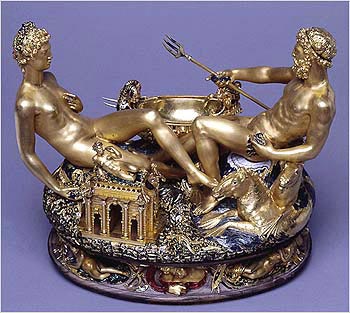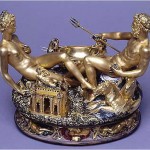According to the Associated Press, the thief of a 16th century, gold-plated sculpture titled "Saliera" has turned himself in to police in Austria. The sculpture was recovered near the town of Zwettl, north of Vienna, buried in a wooden case after the thief called police. The man, who police will not identify, then turned himself in on Friday, January 20.
According to the Associated Press:
The man was photographed by a surveillance camera while buying a cell phone that was then used to send a text message to police during a failed attempt last year to ransom the figurine, the daily Salzburger Nachrichten reported. He went to the police after acquaintances told him he resembled the person being sought.
Authorities have worked to track down the Saliera since it was stolen from a showcase at Vienna's Art History Museum on May 11, 2003.
In May of 2003, the Sydney Morning Herald reported:
Climbing scaffolding and smashing a window, thieves slipped into Vienna's Art History Museum and - despite motion sensors and security guards - disappeared with a 16th-century gold-plated masterpiece sculpted by Benvenuto Cellini.
The theft early on Sunday was one of the biggest art thefts in Europe in recent years. The intricate, 16-centimetre-high sculpture, known as the Saliera, or salt cellar, is valued at about $US57 million ($88 million). It was commissioned from Cellini - one of the Italian Renaissance's most ingenious goldsmiths - in the 1540s by King Francois I of France.The Art History Museum's director, Wilfried Seipel, called the piece the "Mona Lisa of sculptures".
One or more thieves crawled through a broken second-floor window at 4am, shattered the heavy-glass display case, grabbed the sculpture and fled. Police were investigating whether it might have been an inside job. The museum's alarms went off, and all the artwork was protected by motion sensors and video cameras.
The theft was discovered at 8.20am when a museum porter noticed the damage. "The alarm was activated," Mr Seipel told the Austrian TV network, ORF.
- Benevuto Cellini, Saliera, 1541-43.





